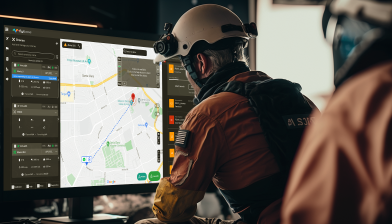Public Safety
Rapidly Respond to Public Emergencies with Autonomous Drones
Equip first responders with autonomous drones for real-time situational awareness, law enforcement, SAR missions; remotely control & manage them with ease from your remote or mobile command centers.
Request Demo






Why use FlytBase for Public Safety?
It is crucial for city officials worldwide to respond quickly to emergencies and life-threatening situations, such as fires and incidents. Sending first responders to an incident scene without all the necessary information, however, can be dangerous, if not fatal.

A bird’s eye view of your site.
Search and Rescue Operations
Keep an eye out for trespassers on industrial or residential property. Receive an alert if there are any intrusions on the property.

Law Enforcement
Monitor areas with criminal activity, as well as areas beyond human reach, to track suspects more quickly and provide greater security.

Fire Response
Gather critical data and provide aerial maps to firefighters, identify potential hotspots, and predict fire path to prevent fire from spreading further.

Disaster Management
Map the areas prone to natural disasters and alert the disaster response team. assisting response time with data analyzed, minimizing damage and saving lives.

How FlytBase redefines public safety drone ops
An interoperable drone autonomy software
Mission Management
Plan a simple waypoint, grid, or corridor mission to acquire drone data, or send the drone to a specific location for emergency response.

Failsafes
Trigger failsafe mechanisms automatically to aid in safe, controlled emergency landings in situations such as when the drone battery is critically low, RC link loss, or LTE link loss.

Advanced Video Management
View live video feeds from multiple drones and docking stations on a single dashboard. Share with team members & stakeholders in real-time.

Parachute Integration
In the unlikely event that the system fails, FlytBase integrates with an autonomous parachute system, allowing it to open automatically and the drone to land safely.

Trusted by drone industry leaders worldwide



-2.png)
Definitive Guide to Setup Drones
for Public Safety
Deploy drones fleets for public safety
The world is witnessing a widespread adoption of drones across different use cases, and drones for public safety is one such application that has yielded significant social and public health benefits. One such example is how drones saved the lives of 279 people, as shared by DJI at AirWorks2019. The total global number is, of course, orders of magnitude more, given the increasingly common use of drones for disaster monitoring, emergency response, search-and-rescue, etc. Software-driven autonomy and automation must, by design, be at the centre of production deployments to truly capture the ‘faster, better, cheaper’ promise of UAV fleets for public safety use-cases.
Get the PDF Version of this Whitepaper for Free!

Resources
Ensure quick emergency response with autonomous drone solutions!



.svg)










-min.png)


.png)

.png)